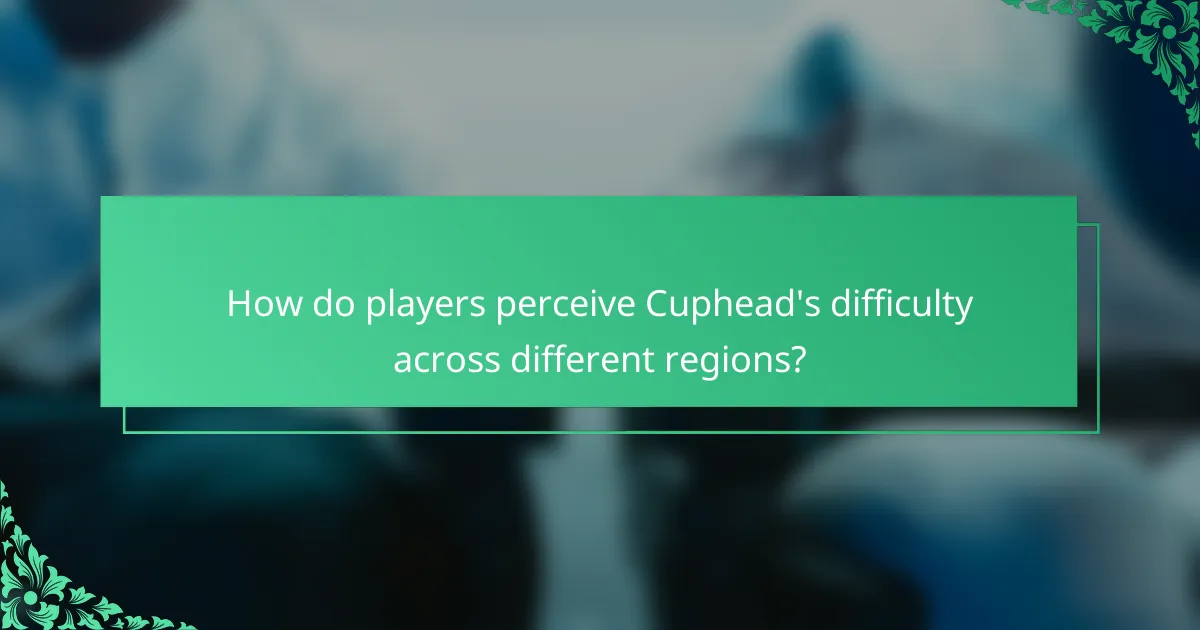Cuphead offers a unique gaming experience with its hand-drawn, 1930s cartoon animation style, challenging difficulty balance, and rich historical references. The game’s visuals enhance player immersion while its gameplay rewards skill development. Players encounter meticulously designed boss battles that reflect both nostalgia and cultural influences. Understanding these elements can deepen engagement and appreciation for Cuphead’s artistry and design philosophy.

What defines the animation style of Cuphead?
The animation style of Cuphead is defined by its hand-drawn, 1930s cartoon aesthetic. This unique style incorporates fluid character movements and vibrant colors, reminiscent of early animation techniques. The game’s art is heavily influenced by vintage cartoons, featuring exaggerated expressions and dynamic backgrounds. Additionally, Cuphead employs a frame-by-frame animation method, enhancing its visual appeal and authenticity.
How does the 1930s aesthetic influence Cuphead’s visuals?
The 1930s aesthetic significantly influences Cuphead’s visuals through its hand-drawn animation style, vibrant colors, and vintage cartoon references. The game emulates the look of classic animations, incorporating techniques like rubber hose animation and exaggerated character movements. This style reflects the era’s artistic trends, creating a nostalgic experience. Additionally, Cuphead’s difficulty balance echoes the challenging gameplay of vintage arcade games, enhancing its retro appeal. The historical references found in character designs and environments further immerse players in the 1930s animation culture.
What techniques are used to achieve the hand-drawn animation effect?
Cuphead achieves the hand-drawn animation effect through traditional techniques like frame-by-frame animation, watercolor backgrounds, and character designs inspired by 1930s cartoons. The meticulous attention to detail creates a unique visual aesthetic. The animation process involves creating individual frames by hand, ensuring a fluid and dynamic movement that reflects the era’s style. Additionally, the use of vintage sound effects and music enhances the nostalgic experience, further immersing players in the game’s artistic vision.
How do color palettes contribute to the overall atmosphere of the game?
Color palettes significantly shape the atmosphere of Cuphead by enhancing its vintage aesthetic and emotional tone. The game utilizes a limited color range reminiscent of 1930s cartoons, creating a nostalgic feel. Bright, vibrant colors evoke joy and whimsy, while darker tones can introduce tension and challenge. This strategic use of color not only complements the gameplay but also reinforces the historical references embedded in its animation style. The contrast of colors contributes to the game’s overall difficulty balance, guiding players’ emotions and reactions throughout their journey.

How does Cuphead balance difficulty for players?
Cuphead balances difficulty through a combination of precise controls, varied enemy patterns, and player feedback. The game employs a steep learning curve but rewards persistence with a sense of achievement. Each boss encounter is meticulously designed, providing a unique challenge while allowing players to develop skills progressively. The visual style enhances this experience, as the hand-drawn animation creates an engaging atmosphere that complements the gameplay.
What design choices impact the game’s challenge levels?
Cuphead’s challenge levels are influenced by its hand-drawn animation style, difficulty balance, and historical references. The unique art style creates visually engaging but complex environments. The game’s difficulty is meticulously balanced, offering a steep learning curve that rewards player skill. Historical references to 1930s cartoons contribute to the overall aesthetic, enhancing immersion and challenge. Each design choice reinforces the game’s identity and player experience, making it both a tribute and a test of skill.
How does player feedback shape the difficulty curve?
Player feedback significantly influences the difficulty curve in Cuphead. Developers analyze player experiences to adjust challenge levels, ensuring the game remains engaging without becoming frustrating. This iterative process involves monitoring player performance and collecting feedback to refine enemy behavior and attack patterns. As a result, the game balances its notorious difficulty with moments of accessibility, enhancing overall enjoyment while preserving its signature challenge.
Which strategies can players employ to overcome tough bosses?
Players can employ various strategies to overcome tough bosses in Cuphead. Mastering patterns is crucial; each boss has unique attack sequences. Timing dodges and parries effectively can minimize damage. Utilizing the right weapons enhances attack efficiency. Players should also consider cooperative play for shared advantages. Finally, patience and practice are key to learning boss mechanics and improving performance.

What historical references can be found in Cuphead?
Cuphead incorporates historical references primarily from the 1930s animation style and early video games. The game’s visuals emulate the hand-drawn aesthetic of classic cartoons, particularly those by Fleischer Studios and Disney. This animation style is characterized by its fluidity and vibrant color palette, reminiscent of the era’s artistic techniques.
Additionally, Cuphead’s gameplay draws inspiration from the challenging nature of early arcade games, reflecting a nostalgic difficulty balance. The characters and settings often reference American folklore and cultural icons, enhancing the game’s rich historical context. For instance, bosses are inspired by various myths and legends, showcasing a unique blend of history and creativity.
How do classic cartoons influence the game’s narrative and characters?
Classic cartoons significantly shape Cuphead’s narrative and characters through their distinctive animation style and humor. The game emulates the 1930s cartoon aesthetic, featuring exaggerated movements and vibrant colors. This visual style enhances character personality, making them memorable and engaging. Additionally, Cuphead’s difficulty reflects the challenging nature of classic cartoons, where characters often faced absurd obstacles. Historical references, such as jazz music and vintage animation techniques, further deepen the game’s narrative, creating a nostalgic experience for players.
What are the notable cultural icons featured in Cuphead?
Cuphead features notable cultural icons from the early 20th century, including characters inspired by classic cartoons. Iconic figures include the anthropomorphic Cuphead and Mugman, reminiscent of vintage animation styles. The game pays homage to various historical references, such as the 1930s cartoon aesthetic and jazz music influences, enhancing its unique charm. The difficulty balance adds to the nostalgic experience, making it a challenging tribute to the era’s animation.
How does Cuphead pay homage to early animation techniques?
Cuphead pays homage to early animation techniques through its hand-drawn art style and frame-by-frame animation. This method mimics the look of 1930s cartoons, capturing the essence of vintage animation. The game incorporates features like rubber hose character design, exaggerated motions, and vintage sound effects, enhancing the nostalgic experience. Additionally, it references iconic animation studios and techniques, celebrating the history of animation while offering a challenging gameplay experience.

How do players perceive Cuphead’s difficulty across different regions?
Players perceive Cuphead’s difficulty as challenging yet fair, with regional differences influencing their experiences. In North America, players often view the difficulty as a nostalgic nod to classic games, appreciating the skill required. In contrast, players from Japan tend to focus on the precision and timing aspects of gameplay, often embracing the challenge as part of the experience. Cultural attitudes towards difficulty in gaming play a significant role in these perceptions. For example, players in regions with a strong emphasis on competitive gaming may find the challenge more rewarding, while others may see it as frustrating. Overall, Cuphead’s design elements, including its animation style and historical references, contribute to a multifaceted understanding of difficulty across different player demographics.
What common challenges do players face in the UK versus the US?
Players in the UK face different challenges in “Cuphead” compared to those in the US. UK players often encounter issues with game accessibility and regional pricing, while US players may struggle with the game’s difficulty and cultural references.
In the UK, the animation style resonates with a different historical context, potentially leading to varied interpretations of the game’s themes. The difficulty balance can also feel more punishing due to the high expectations set by local gaming culture.
Conversely, US players might find the historical references more familiar, which can enhance their engagement. However, the game’s notorious difficulty level remains a shared challenge for both regions, testing players’ skills and patience.
Overall, while the core gameplay experience is consistent, regional differences influence how players interact with the game’s elements.
How do cultural attitudes towards gaming impact player experiences?
Cultural attitudes towards gaming significantly shape player experiences in “Cuphead.” Players often appreciate its unique animation style, which reflects classic cartoons, enhancing nostalgia and engagement. The game’s notorious difficulty balance, influenced by cultural expectations of challenge, fosters a sense of accomplishment among players. Historical references in “Cuphead” resonate with audiences familiar with early 20th-century animation, creating deeper connections to the game’s aesthetic and narrative. These elements combined reflect how cultural perceptions of gaming can enrich or hinder player experiences.

What are the common misconceptions about Cuphead’s animation and difficulty?
Cuphead’s animation is often mistaken as being solely traditional, while its difficulty is frequently underestimated. The hand-drawn 1930s cartoon style combines with challenging gameplay, creating a unique experience. Many believe the game is excessively difficult, but it balances skill and learning curves effectively. Critics may overlook the historical references and artistic detail that enhance player immersion. Misconceptions arise from the game’s visual appeal overshadowing its gameplay depth and design philosophy.
How do myths about the game’s difficulty affect new players?
Myths about Cuphead’s difficulty often intimidate new players, affecting their willingness to engage with the game. Many believe the game is excessively hard, which can create a barrier to entry. This perception can overshadow the game’s unique animation style and historical references, leading potential players to miss out on its artistic and narrative richness. Additionally, the challenge is balanced with rewarding gameplay mechanics, encouraging perseverance rather than discouragement. Understanding that difficulty is part of the game’s charm can help new players appreciate it more fully.
What misunderstandings exist regarding the animation process?
Many misunderstandings exist about the animation process in Cuphead. Some believe the animation is entirely hand-drawn, while it combines traditional techniques with digital enhancements. Others underestimate the challenge of synchronizing the animation with gameplay, often viewing it as a straightforward task. Additionally, the historical references, inspired by 1930s cartoons, lead to misconceptions about the simplicity of the art style, overlooking the intricate details and labor-intensive work involved. The balance between difficulty and visual appeal is often misinterpreted, as players may assume that the aesthetic directly correlates with ease of gameplay.

What best practices can enhance the Cuphead gaming experience?
To enhance the Cuphead gaming experience, focus on mastering its unique animation style, adjusting the difficulty balance, and appreciating its historical references.
The animation style is inspired by 1930s cartoons, which creates a visually captivating environment. Embrace the hand-drawn aesthetics and fluid animations to fully appreciate the artistry.
Balancing difficulty is crucial. Use practice modes to familiarize yourself with enemy patterns and mechanics. This approach allows for gradual skill improvement and a more enjoyable challenge.
Lastly, explore the historical references embedded in the game. Understanding these elements can deepen your engagement and enrich your overall experience.
How can players effectively prepare for challenging levels?
Players can effectively prepare for challenging levels in Cuphead by mastering the game’s unique mechanics and understanding its animation style. Focus on practicing boss patterns to anticipate attacks. Utilize co-op play for strategic advantages and shared resources. Study historical references in level design to appreciate nuances and gain insight into enemy behavior. Maintain patience and practice to improve timing and precision, essential for overcoming difficult segments.
What tips can improve understanding of the animation style?
To improve understanding of Cuphead’s animation style, focus on its historical influences and unique artistic techniques. Analyzing the hand-drawn visuals and vintage cartoon aesthetics enhances appreciation. Study the fluid character movements and intricate backgrounds, which reflect early 20th-century animation. Engaging with behind-the-scenes content reveals the creative process, enriching the overall experience.


